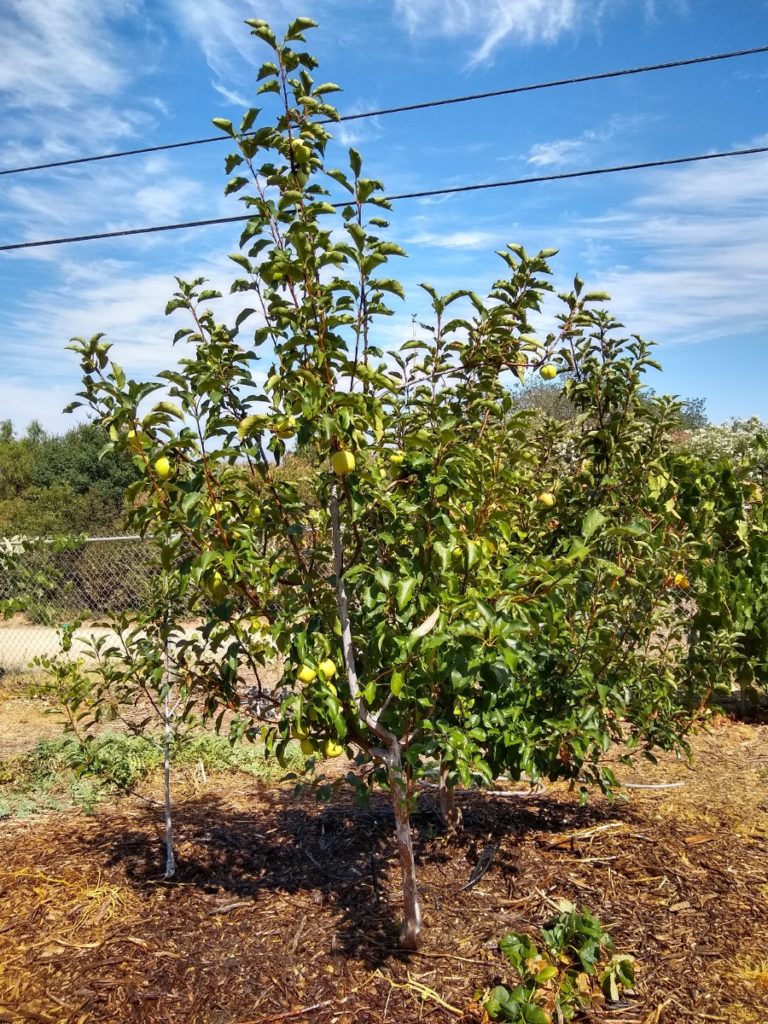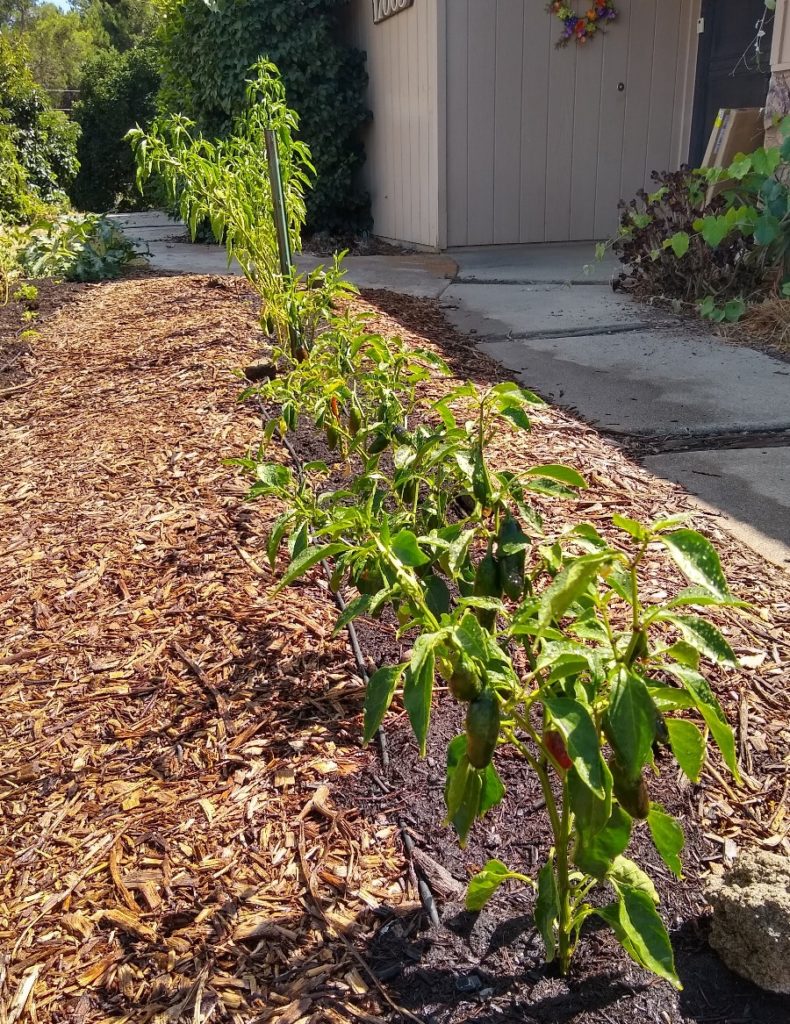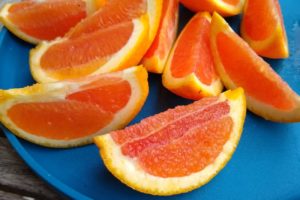How often do you adjust your irrigation timer? How do you estimate how much to water your fruit trees or vegetables? The local evapotranspiration rate is a great guide in answering both of these questions.
What is the evapotranspiration rate? Evapo-transpiration is a portmanteau of evaporation and transpiration. Evapotranspiration is the amount of water that is lost by a plant due to evaporation of water from the surface of the soil beneath and around the plant, as well as the transpiration of water from plant leaves. Plants “breathe” out water from little holes in their leaves.
So in short, the evapotranspiration rate is how much water a plant is using.
What’s the point in knowing the evapotranspiration rate of a plant? It can help you estimate how much water to give the plant, to replace the water it is using, so it can keep growing well.
ET rate fluctuates through the seasons
I make gardening calendars each year that show what to plant in my vegetable garden each month and what to do for my fruit trees, in addition to listing the evapotranspiration rate (ET rate) for each month. The ET rate is constantly changing, just as the seasons are constantly changing.
In Southern California, the highest ET rate occurs in July. That means that plants use the most water in July. Plants use the least water in December.
Here is the first way to use the ET rate to help you water your garden better: Just notice that the ET rate in July is 6.51 inches for the zone in which most people live in Southern California compared to 1.86 inches for the month of December, which means that plants use only 35% as much water in December as they use in July. Put another way, plants use nearly three times as much water in July as they do in December.
The lesson here is that you should water a whole lot more in July as you should in December, or just as importantly, you should water far less in December than in July. But of course you already knew that.
It’s obvious: July is hot and dry; December is chilly and a little rainy. But the ET rate quantifies the difference, that’s the advantage of paying attention to it.
How is the ET rate determined?
Actually, the ET rate is the amount of water that a cool-season grass that is cut to four inches tall uses when in full sun and given access to an unlimited supply of water. That’s a mouthful, I know, but the takeaway is that the ET rate is not exactly how much water your particular Satsuma mandarin tree or your lettuce plants are using. (More on this later.)
Patches of grass are maintained in locations throughout California, the water they use is measured, and the information is uploaded onto a website that is accessible to you and me.
The acronym for this website and system is CIMIS, which stands for California Irrigation Management Information System. There you can find both historical average ET rates recorded at locations near you, as well as recent ET data. The ET readings are taken every hour of every day. What was the ET yesterday? Check and find out.
The CIMIS station nearest me is in Escondido (Station number 153), and the ET measured there yesterday was 0.21 inches.
Here is a very useful map of ET zones in California, along with a table showing historical average ET rates for each month. I think of Zone 6 on that map as being an average zone for where most of us live in Southern California.
Rather than using the actual ET rates from a location near you, you can still likely improve your garden watering by referring to these historical averages.
Using the ET rate to estimate how much to water
Which brings me to the second main way that ET information can help you water your garden better. Let’s say you have a Pink Lady apple tree and you’re wondering how much you should water it. I do have one of those, actually!

ET can help. But you have to do a little math.
You calculate the area of ground that your Pink Lady apple tree covers, and then you find the number of inches that such an area is using. This tree is about five feet wide, so that’s 20 square feet. (Area of a circle is 3.14 times radius times radius.) The historical average ET rate for September in Zone 6 is 4.8 inches, so I can consider giving the tree that much over the course of the month.
But don’t you think it’s more useful to know how many gallons to apply? Convert the inches into gallons by multiplying by 0.623. (One inch of water over one square foot is equal to 0.623 gallons.) That gives me about three gallons per square foot. So I’ll multiply three by 20 (square feet) to get 60. That’s how many gallons this Pink Lady apple tree is approximately going to use during the month of September. (I can then split it into weekly waterings by dividing by four, for example.)
You can use the same formula to estimate water needs for a vegetable bed or row. Here’s a row of peppers in my yard.

It’s about 20 feet long and 1.5 feet wide. So the area that the pepper plants cover is about 30 square feet. (Area of a rectangle is length times width.)
Now how much should I water them through September, approximately? That’s 4.8 (inches) times 0.623 times 30 (square feet). The number of gallons comes out to about 90 for all of September.
ET is best used only to estimate
There you have an estimate for how much water your fruit tree or vegetables are using, but remember that this is only an estimate, and a rough one at that. It should be used just to get you started or to confirm that your watering is in the ballpark of appropriate. There are myriad factors that make your plants use a slightly different amount of water than the same plants in another setting.
You’ve got other plants nearby that might have roots also drinking from the soil around a given plant; there are actually other trees very close to that Pink Lady apple, for instance.
You may have a driveway nearby that reflects sunlight and heat and increases a plant’s water use.
Or your plants might not be in full sun all day, thereby decreasing their water use; my pepper plants get shade from about 3 o’clock in the afternoon, for instance.
And on and on.
So always, you must observe your plants and the soil moisture where their roots are to help you adjust your watering because a home garden situation is actually far more complicated than a farm situation, where ET rates are easier to apply.
ET gauges water use, not necessarily irrigation needs
Then there is the fact that the ET rate quantifies how much water a plant is using, but that is not the same as the amount of water that needs to be given to it in the form of irrigation.
In my garden, for example, I often find that I need to give my vegetables and fruit trees more water in late August and early September than at any other time of the year — and yet, the ET rate is not the highest in late August and early September. It’s higher in late June and July. However, in late June and July there is usually at least a little bit of moisture left in the soil from the winter’s rains that the plants can access whereas by the very end of summer there is little to none still available. (That’s my best guess at what explains what I observe, anyway.)
ET varies a bit among different plant types
Also, the ET rate is for a cool-season grass but you’re growing a Pink Lady apple tree or a bed of romaine lettuce, which use slightly different amounts of water. For some plants, scientists have worked out what they call crop coefficients to help apply the reference ET rate (ET rate of the grass) to your specific plants. For example, it has been determined that avocados in California use about 86% of the ET rate of cool-season grass. Therefore, you may not need to give an avocado tree quite as much water as a similarly sized patch of grass.
In general, most vegetables and fruit trees use only a bit less or more water than similarly sized patches of grass. (See this graph of a few crop coefficients (called Kc).) (Also see this list of crop coefficients for numerous vegetables and fruit trees.)
But you don’t need to get deep into the details of evapotranspiration rates and how they’re generated and modified and applied in order to use them to help you water your garden better.
Just let them show you the fluctuation of water use by plants from season to season, and adjust your watering or timer accordingly. And let them give you a basis upon which to calculate an estimate to start watering a new fruit tree or vegetable garden so that you can rest assured that you’re not way overwatering or underwatering it. Observe and adjust from there.
You might also like to read:




I live in east LaCosta. Have raised redwood beds. What varieties do you recommend for cauliflower and broccoli? Last year, first plantings of broccoli were infested, stunted by aphids.
Had good shishito peppers this summer. Planted green beans from seed 4 weeks ago, and looks like I might have some for fall.
Bad blossom end rot on some tomatoes this summer. Read I need to enrich soil with bone meal. Looking for a better variety for my growing zone for next year.
Had good luck with the Indigo tomato. Prolific.
Hi Leslie,
I’ve never grown a variety of broccoli or cauliflower that I didn’t like. They’re all a bit different, but I’ve never found one that I just have to grow every year or would never grow again. Here’s my post on growing broccoli and cauliflower, which lists some of the varieties I’ve grown: https://gregalder.com/yardposts/growing-broccoli-and-cauliflower-in-southern-california/
As for aphids on broccoli and cauliflower, they’re tough in some years and almost non-existent in others. I wrote about dealing with them here: https://gregalder.com/yardposts/dealing-with-aphids-broccoli-brussels-sprouts-cabbage-cauliflower/
As far as I’ve read and experienced, there’s nothing you can add to your soil to prevent or cure blossom end rot on tomatoes. Certain varieties get it more than others, and often it’s worse in the early part of summer on every variety (apparently, warm soil helps mitigate it).
I bet you’re going to get some great beans this fall. A couple summers ago, I sowed some beans late and got such a great crop from them all through fall.
Thank you Greg. Love your blog. Leslie
Okay that is all good on how to estimate a water need for a given area, so how do you actually translate that into watering the plants? Can you hand water, and know what you are watering? Or do you have to set up a drip system? Or use sprinklers? and then how do you know how much water you are applying? I am a total newbee to all of this water science, I just take my hose and pour a bunch on, let it soak in, and repeat that about 3 times, and I am probably erroring on the side of over watering. I can find very little info on how to set up a watering system and how to use those new smart timers, I would love to do that, but I can’t find any info or professionals that know how to do this. Someone needs to do a comprehensive you tube video series on how to set up and run and monitor a smart watering system, that would be great.
Hi Robin,
I hear your frustration with translating the numbers into actually watering your plants. It takes some time and effort, but there are ways to get the answers to all of your questions.
For a hose, as you use, you just stick it into a bucket and time it. What I do is try to time it for 30 seconds or one minute and see how much the bucket has filled up. (This makes the math easy.)
Let’s say that you’re using a five-gallon bucket and after one minute it has filled up around half way. Then you know that your hose is applying about 2.5 gallons per minute. Now you can run the hose for as long as you need to in order to apply however much water you want.
If you use a sprinkler, you can stick it in a bucket and time it just like the hose.
A drip system is easier because every drip emitter applies a specified volume of water, for example, two gallons per hour. You just add up the drip emitters.
On one of my fruit trees I have eight drip emitters that each apply 0.5 gallons per hour, so that’s four gallons per hour total. If I want to give the tree 10 gallons, then I run the system for two hours and 30 minutes.
Mr. Adler
I have 35-40 pomegranates this year and wonder how I can store them until I need them. Some have cracked open, and I will use them in a few days.
Thank you.
Leonard Chapman
Hi Leonard,
Maybe what we do at our house will work for you. We pick the ripest ones first; that means the ones that have cracked open. But there’s always a wide range of maturity with the fruit on the tree as a whole so others might not be ready to pick for another month or two. Just let those pomegranates “store” on the tree until they’re mature.
For the last ones, you can pick them and leave them on the kitchen counter for weeks. Pomegranates are very sow to spoil.
Also, you can open them up and remove the arils and keep them in a plastic bag in the fridge for a long time. I’ve never tested how long, but weeks for sure.
With one of our pomegranate trees, we end up eating its fruit over the span of about four months.
I just wanted to say that I use the Rachio irrigation controller which uses weather data to help calculate the ET rate, in/hr irrigation water application rate, run-time, and allowable depletion before irrigating again. That is one area I’m still trying to dial in, irrigation frequency. From my reading recommendation is to irrigation after 40% depletion for optimum growing conditions. The Rachio app allows you to change all the parameters to change irrigation frequency and duration based on ET and your specific growing conditions such as soil, sun exposure, precipation rate, slope, and square feet of the irrigations zone.
Cool to hear, Justin. I was talking to a friend about his “smart” irrigation controller the other day, which he loves.
How are your plants looking this summer while using the Rachio controller? Any sense on whether you’re using more or less water now than before?
Irrigation frequency is something I constantly fiddle with and constantly learn more about. One thing I’ve finally come to truly understand is that there is no perfect frequency, there is just a range of good frequencies for any particular plant in any particular setting.
I think this irrigation frequency topic deserves a post of its own.
Thanks so much for your great article. I realize it’s “rule of thumb” but I want to be sure I haven’t confused myself in the interpretation. I’m zone 6. Using 60/4 =15 gallons per week, watering every 4 days = 2x weekly x 7.5 gallons =15 gallons.
When I reference the chart, I think it’s saying 17.6 twice a week or 35gals per week. Where have I gone wrong? Thank You
USING THE EVAPOTRANSPIRATION RATE TO WATER YOUR GARDEN BETTER
But don’t you think it’s more useful to know how many gallons to apply? Convert the inches into gallons by multiplying by 0.623. (One inch of water over one square foot is equal to 0.623 gallons.) That gives me about three gallons per square foot. So I’ll multiply three by 20 (square feet) to get 60. That’s how many gallons this Pink Lady apple tree is approximately going to use during the month of September. (I can then split it into weekly waterings by dividing by four, for example.)
Hi Randy,
Sorry, but I’m confused. Which chart are you referencing?
My Grandma Puebla Avocado tree approx 55 years old is being sold with a home in Modesto. Any ideas on how to be sure it is not cut down?
Hi Laura,
I don’t know how you could prevent someone from cutting the tree down, but you could take some wood from it and graft a new tree to keep it alive in a different way. I’ve done that with some old fruit trees that my great-great grandfather planted near Los Angeles.
Hi Greg
So glad to find your posting on how to find ET for our own area. I just learned of ET while reading Robert Kourik’s Drip Irrigation book. I’ve been struggling with water in my raised veggie beds and fruit trees. I’m not finding the ET forecast on the NWS webpage. What am I looking for?
https://www.weather.gov/wrh/wxtable
I did find the map and that will give me a start on ‘doing the math’. Thanks!
Hi Carla,
That page must have changed. You’re right that there’s no ET forecast there anymore. I’ll update the link if I can find the new location.